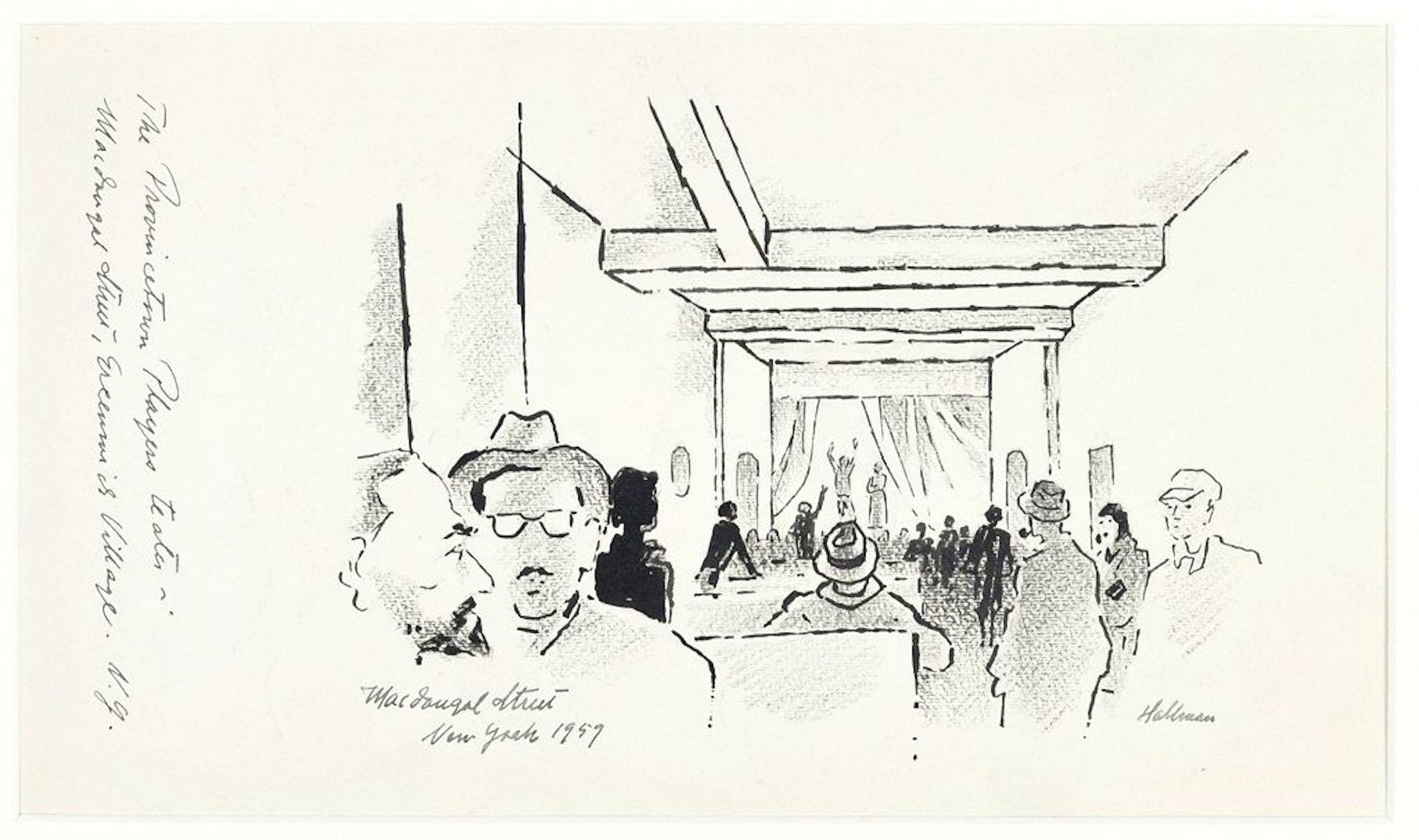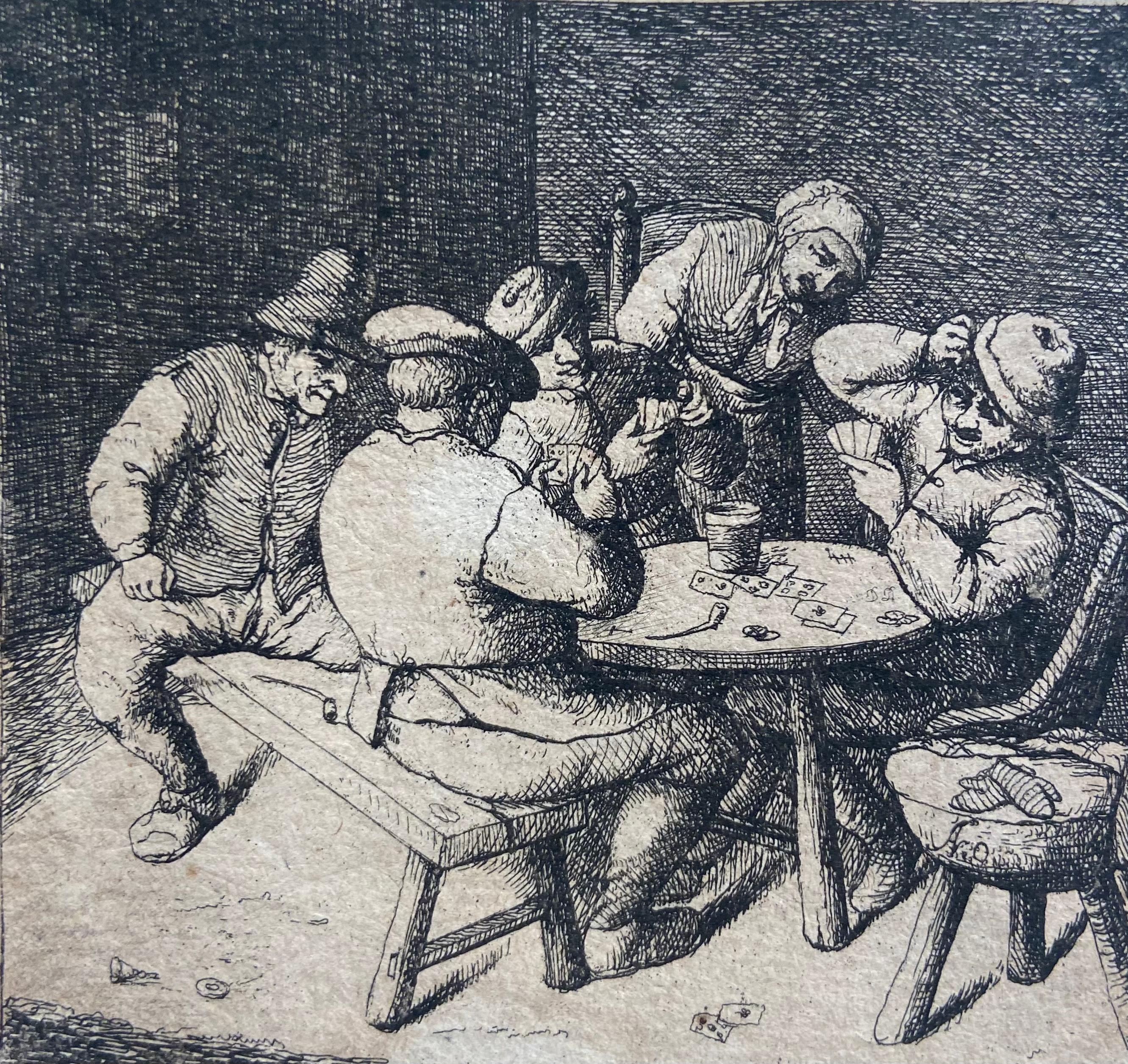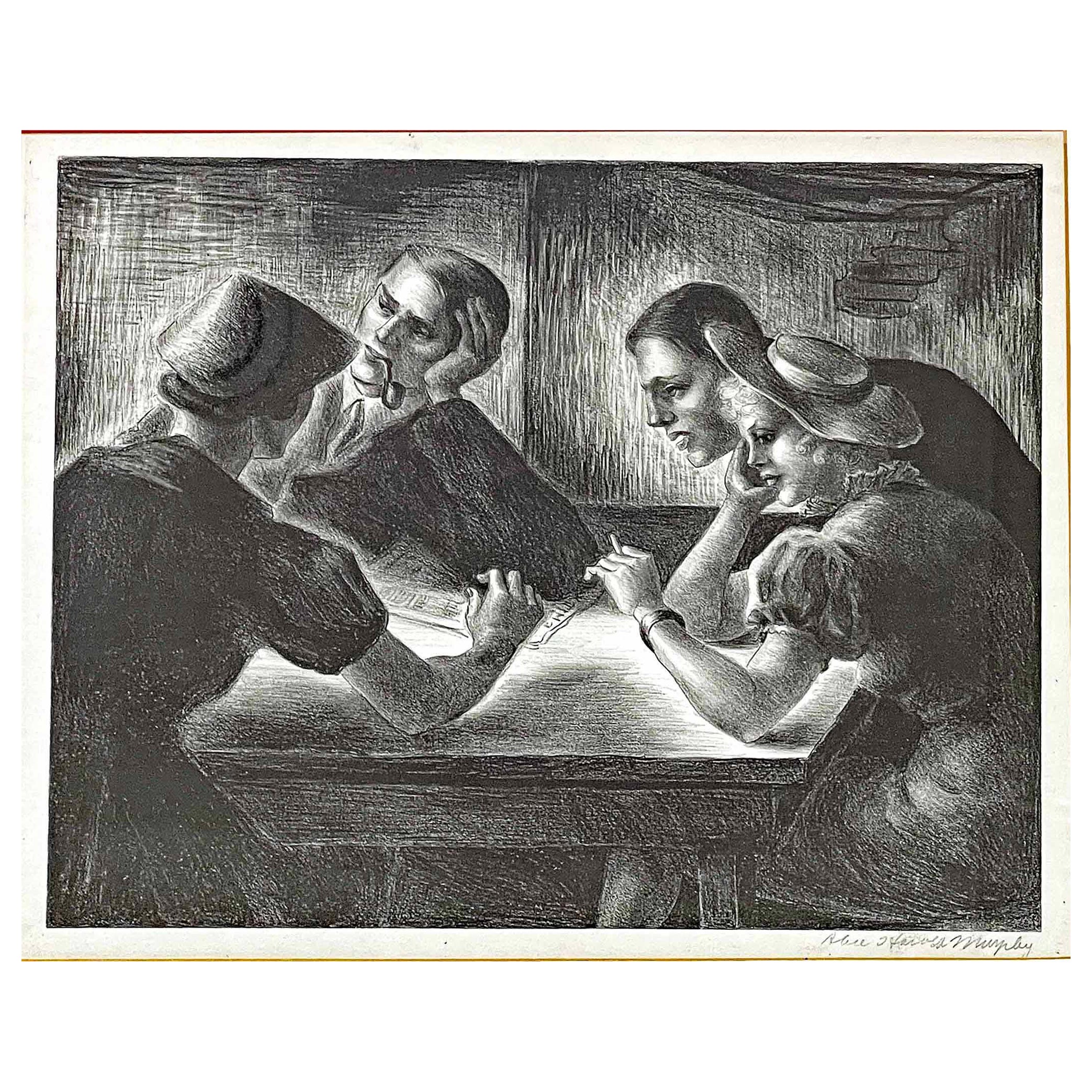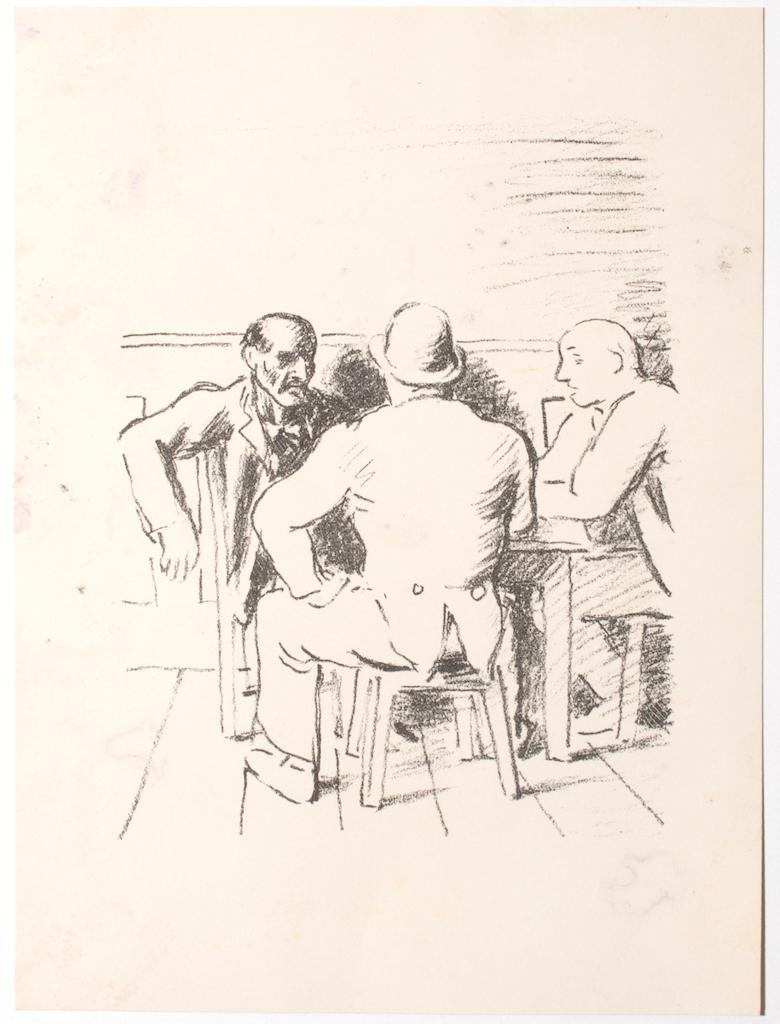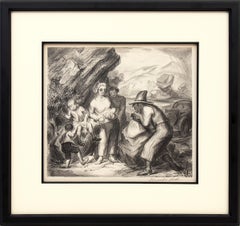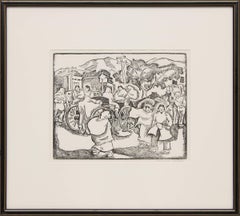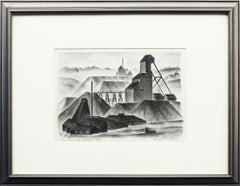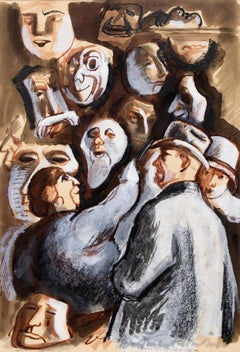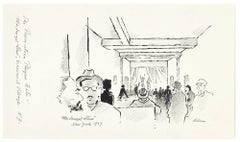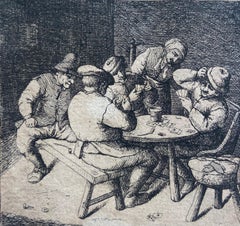Items Similar to Card Players (16/100), 1959 Framed Figurative Lithograph Print, Interior Scene
Want more images or videos?
Request additional images or videos from the seller
1 of 17
Kenneth Miller AdamsCard Players (16/100), 1959 Framed Figurative Lithograph Print, Interior Scenecirca 1959
circa 1959
$2,200
£1,670.95
€1,930.50
CA$3,083.38
A$3,450.88
CHF 1,801.09
MX$42,082.97
NOK 23,051.56
SEK 21,821.26
DKK 14,407.10
Shipping
Retrieving quote...The 1stDibs Promise:
Authenticity Guarantee,
Money-Back Guarantee,
24-Hour Cancellation
About the Item
This lithograph titled Card Players 16/100, created by renowned artist Kenneth Miller Adams (1897-1966) around 1959, captures a lively interior scene of several male figures engrossed in a card game. The print is an exceptional example of Adams' figurative work, showcasing his skill in portraying dynamic social moments. The lithograph is presented in a sleek black frame with archival materials, and the outer dimensions of the framed piece are 25 ⅝ x 31 ¼ x 1 ⅛ inches. The image sight size is 18 ½ x 24 ¼ inches.
This piece remains in excellent condition, clean, and well-preserved. Please contact us for a detailed condition report.
Provenance: Private Collection, Denver, Colorado
Expedited and international shipping is available—please reach out for a quote.
About the Artist:
Kenneth Miller Adams, born in Kansas in 1897, began his art career in Topeka in 1913, studying under artist G.M. Stone. He later continued his education at the Art Institute of Chicago before serving in World War I. After his service, Adams studied at the Art Students League in New York City and then traveled abroad to immerse himself in Italian and French art.
In 1924, Adams returned to Kansas, where his friend Andrew Dasburg encouraged him to move to Taos, New Mexico. There, Adams became the youngest and final member of the Taos Society of Artists. He taught at the University of New Mexico in Taos starting in 1929, later becoming a full professor in 1963 after moving to Albuquerque. Adams was known for his contributions to American regionalism, and his works continue to reflect the cultural richness of the Southwest.
This original lithograph is a fine example of his mid-20th-century work and makes a distinctive addition to any collection of figurative or American art.
- Creator:Kenneth Miller Adams (1897-1966, American)
- Creation Year:circa 1959
- Dimensions:Height: 25.5 in (64.77 cm)Width: 31.25 in (79.38 cm)Depth: 1.25 in (3.18 cm)
- Medium:
- Movement & Style:
- Period:
- Framing:Frame IncludedFraming Options Available
- Condition:
- Gallery Location:Denver, CO
- Reference Number:Seller: 258471stDibs: LU27310510362
About the Seller
5.0
Gold Seller
Premium sellers maintaining a 4.3+ rating and 24-hour response times
Established in 1979
1stDibs seller since 2013
290 sales on 1stDibs
Typical response time: 13 hours
- ShippingRetrieving quote...Shipping from: Denver, CO
- Return Policy
Authenticity Guarantee
In the unlikely event there’s an issue with an item’s authenticity, contact us within 1 year for a full refund. DetailsMoney-Back Guarantee
If your item is not as described, is damaged in transit, or does not arrive, contact us within 7 days for a full refund. Details24-Hour Cancellation
You have a 24-hour grace period in which to reconsider your purchase, with no questions asked.Vetted Professional Sellers
Our world-class sellers must adhere to strict standards for service and quality, maintaining the integrity of our listings.Price-Match Guarantee
If you find that a seller listed the same item for a lower price elsewhere, we’ll match it.Trusted Global Delivery
Our best-in-class carrier network provides specialized shipping options worldwide, including custom delivery.More From This Seller
View All1930s Lithograph Print of Tourists at Garden of the Gods, Colorado Springs, CO
By Charles Locke
Located in Denver, CO
"Photo Opportunity" is a rare and captivating original lithograph by American Modernist Charles Wheeler Locke (1899–1983), created circa 1935. This lim...
Category
1930s American Modern Figurative Prints
Materials
Lithograph, Paper
Saturday Morning Market, Taos Plaza, New Mexico, 1950s Figural Linocut Print
By Barbara Latham
Located in Denver, CO
"Saturday Morning (Market, Taos Plaza, New Mexico)" is a striking 1950s modernist linocut print by renowned New Mexican artist Barbara Latham. This vivid print captures a bustling Sa...
Category
Mid-20th Century American Modern Figurative Prints
Materials
Linocut
Silver Mine, Russell Gulch, CO (12/25) 1930s American Modern Lithograph Print
By Arnold Rönnebeck
Located in Denver, CO
"Silver Mine, Russell Gulch (12/25)" is a captivating black and white lithograph by American artist Arnold Ronnebeck. The piece features a mining scene in Russell Gulch, Colorado, wi...
Category
1930s American Modern Figurative Prints
Materials
Lithograph
Vendor of Masks, 1930s Original Modernist Gouache Painting of Carnival Scene
By Boardman Robinson
Located in Denver, CO
This captivating 1930s modernist gouache painting by Boardman Robinson (1876–1952), titled The Vendor of Masks, depicts a striking mask vendor’s display with male and female figures,...
Category
1930s American Modern Figurative Paintings
Materials
Gouache
Artists Sketching, California, 1940s Large Modernist Gouache Painting, Landscape
By Frederick Shane
Located in Denver, CO
This original 1940s American Modernist gouache painting, "Artists Sketching (California)," captures a dynamic scene of three artists at work against a majestic mountain backdrop. With expressive brushwork and a rich color palette, the piece embodies Frederick E. Shane’s signature blend of realism and modernist abstraction. Signed, titled, and dated by the artist in the lower margin, this remarkable artwork reflects the era’s Regionalist influence and the artist’s keen eye for capturing creative moments in the natural landscape.
The painting is professionally housed in a custom archival frame, ensuring long-term preservation. Frame dimensions: 25.5 x 37.5 x 1.5 inches. Image size: 20.25 x 29.75 inches.
Provenance: Estate of the Artist, Frederick Shane
About the Artist: Frederick E. Shane (1906-1992)
A celebrated Missouri Regionalist painter and printmaker, Frederick E. Shane was known for his compelling genre scenes, landscapes, seascapes, and portraits in a variety of media, including oil, watercolor, gouache, tempera, and lithography. While fundamentally a realist, Shane often incorporated elements of abstraction, expressionism, and surrealism, adding depth and emotion to his compositions.
During the summers of 1925-26, Shane studied under Randall Davey at the Broadmoor Academy in Colorado Springs, an institution founded in 1919 by philanthropists Spencer and Julie Penrose. Shane remained closely connected to the Colorado Springs Fine Arts Center, the Academy’s successor, throughout the 1940s and early 1950s, participating in Artists West of the Mississippi exhibitions and forming lasting friendships with key figures like Boardman Robinson and Adolph Dehn...
Category
1940s American Modern Landscape Paintings
Materials
Gouache
Artist and His Family, 1950s Interior Figurative Oil Painting, American Modern
Located in Denver, CO
"Artist and His Family" is a captivating 1950 oil on board painting by renowned American artist Donna Marecak (1922-1998). This intimate interior scene f...
Category
1950s American Modern Figurative Paintings
Materials
Oil
You May Also Like
The Card Players - Lithograph, Mourlot
By Roger de la Fresnaye
Located in Paris, IDF
Roger de la Fresnaye
The Card Players
Stone lithograph after a painting
Printed in Mourlot workshop
On Arches vellum 65 x 50 cm (c. 26 x 20 inch)
Ex...
Category
1960s Cubist Figurative Prints
Materials
Lithograph
Provincetown Players - Original Monotype Lithograph by A. Hallman - 1959
By Adolf Hallman
Located in Roma, IT
Provincetown Players is a beautiful black and white lithograph on "C. M. Fabriano" watermarked paper, made by the Swedish illustrator and reporter Adolf Reinhold Hallman in 1959. The state of preservation is excellent. On the back the blue ink stamp "Made in Italy by Adolf Hallman, 54 Via Margutta Roma". at the center of the sheet. Including a white cardboard passepartout, cm 34 x 49.
On the lower margin and on the right margin there are black ink hand-written notes, inside the image, the date and the signature “Hallmann”.
The inscription that gives the title to the artwork refers to the American theatrical organization began performing in 1915 in Provincetown founded by a nontheatre group of writers and artists whose common aim was the production of new and experimental poetry.
In 1916 the group produced in New York City Eugene O’Neill’s Bound East for Cardiff and Thirst, thus launching the career of one of America's distinguished playwrights. So Provincetown Players took up residence in New York City’s Greenwich Village, as Hallman reports on lower margin, and for years thereafter discovered and developed the work of such noted writers, designers, and actors as Donald Oenslager, Kenneth Macgowan, Jasper Deeter, and Paul Green...
Category
1950s Figurative Prints
Materials
Monotype
The Card Players, Late 18th Century British Etching
Located in London, GB
Etching laid on paper
Image size: 3 1/4 x 3 1/4 inches (8 x 8 cm)
This etching is after a work by Adriaen van Ostade, a 17th century Dutch artist.
This wonderful etching shows a gr...
Category
Late 18th Century Interior Prints
Materials
Etching
Price Upon Request
Tavern - Etching by Marcel Gromaire - 1952
By Marcel Gromaire
Located in Roma, IT
Tavern is a black and white etching on paper, realized in 1952 by Marcel Gromaire (1892-1971).
Monogrammed on plate on the lower left corner.
Good conditions except for some foxing...
Category
1950s Post-Impressionist Figurative Prints
Materials
Etching
"Four at the Table", 1940s American Scene Lithograph by Woman Artist
Located in Philadelphia, PA
One of the most intriguing and mysterious WPA-era prints we have ever offered, this rare, possibly unique work depicts a group of two women and two men in intense conversation at a crude wood table, in a simple room with cracks in the plaster that show the wood lath underneath. The four almost seem like a group on the lam in a film noir from the period, desperately running from a crime of some kind. Two of the four face downward, deeply focused on the subject at hand, and another is lost in thought, a pipe in his mouth. The fourth is most mysterious of all, facing away from the viewer. but clearly animated and in conversation. The artist was Alice Harold Murphy...
Category
Vintage 1940s American Art Deco Prints
Materials
Paper
$2,000 Sale Price
20% Off
The Meeting - Original Lithograph - Mid-20th Century
Located in Roma, IT
The Meeting is an original lithography artwork on paper realized by Anonymous Artist in the mid-20th Century.
In good condition, with small foxing.
The artwork represents seated me...
Category
Mid-20th Century Modern Portrait Prints
Materials
Lithograph
More Ways To Browse
Card Players
Isaac Soyer
Mckenney And Hall Lithograph
Used Brillo Pads
Katz Ada
Robert Longo Lithographs
Picasso Portrait Jacqueline
George Catlin Prints
Paul Cesar Helleu
Andy Warhol Queen
Mckenney Hall Folio
Spy Leslie Ward
Life Size African Wood Sculpture
Wall Street Bull
Chalcographie Du Louvre
Chalcographie Du Louvre Prints
Portrait Of Dora Maar
Henri Matisse Linocut
